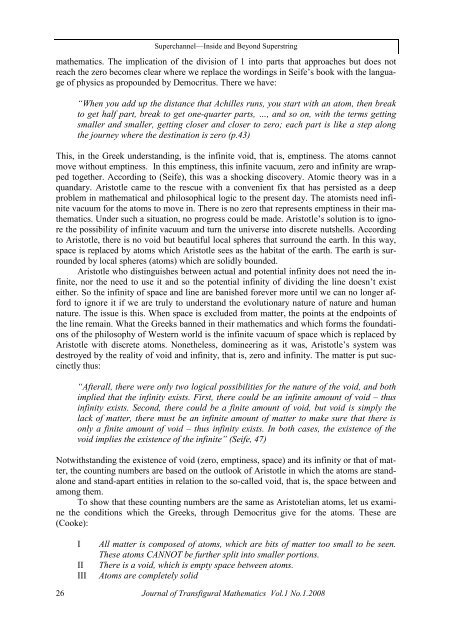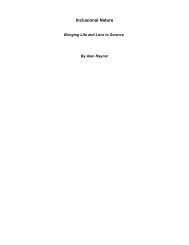JTfM Vol 1 No 1 2008 - ONLINE EDITION - Inclusionality Research
JTfM Vol 1 No 1 2008 - ONLINE EDITION - Inclusionality Research
JTfM Vol 1 No 1 2008 - ONLINE EDITION - Inclusionality Research
Create successful ePaper yourself
Turn your PDF publications into a flip-book with our unique Google optimized e-Paper software.
Superchannel—Inside and Beyond Superstring<br />
mathematics. The implication of the division of 1 into parts that approaches but does not<br />
reach the zero becomes clear where we replace the wordings in Seife’s book with the language<br />
of physics as propounded by Democritus. There we have:<br />
“When you add up the distance that Achilles runs, you start with an atom, then break<br />
to get half part, break to get one-quarter parts, …, and so on, with the terms getting<br />
smaller and smaller, getting closer and closer to zero; each part is like a step along<br />
the journey where the destination is zero (p.43)<br />
This, in the Greek understanding, is the infinite void, that is, emptiness. The atoms cannot<br />
move without emptiness. In this emptiness, this infinite vacuum, zero and infinity are wrapped<br />
together. According to (Seife), this was a shocking discovery. Atomic theory was in a<br />
quandary. Aristotle came to the rescue with a convenient fix that has persisted as a deep<br />
problem in mathematical and philosophical logic to the present day. The atomists need infinite<br />
vacuum for the atoms to move in. There is no zero that represents emptiness in their mathematics.<br />
Under such a situation, no progress could be made. Aristotle’s solution is to ignore<br />
the possibility of infinite vacuum and turn the universe into discrete nutshells. According<br />
to Aristotle, there is no void but beautiful local spheres that surround the earth. In this way,<br />
space is replaced by atoms which Aristotle sees as the habitat of the earth. The earth is surrounded<br />
by local spheres (atoms) which are solidly bounded.<br />
Aristotle who distinguishes between actual and potential infinity does not need the infinite,<br />
nor the need to use it and so the potential infinity of dividing the line doesn’t exist<br />
either. So the infinity of space and line are banished forever more until we can no longer afford<br />
to ignore it if we are truly to understand the evolutionary nature of nature and human<br />
nature. The issue is this. When space is excluded from matter, the points at the endpoints of<br />
the line remain. What the Greeks banned in their mathematics and which forms the foundations<br />
of the philosophy of Western world is the infinite vacuum of space which is replaced by<br />
Aristotle with discrete atoms. <strong>No</strong>netheless, domineering as it was, Aristotle’s system was<br />
destroyed by the reality of void and infinity, that is, zero and infinity. The matter is put succinctly<br />
thus:<br />
“Afterall, there were only two logical possibilities for the nature of the void, and both<br />
implied that the infinity exists. First, there could be an infinite amount of void – thus<br />
infinity exists. Second, there could be a finite amount of void, but void is simply the<br />
lack of matter, there must be an infinite amount of matter to make sure that there is<br />
only a finite amount of void – thus infinity exists. In both cases, the existence of the<br />
void implies the existence of the infinite” (Seife, 47)<br />
<strong>No</strong>twithstanding the existence of void (zero, emptiness, space) and its infinity or that of matter,<br />
the counting numbers are based on the outlook of Aristotle in which the atoms are standalone<br />
and stand-apart entities in relation to the so-called void, that is, the space between and<br />
among them.<br />
To show that these counting numbers are the same as Aristotelian atoms, let us examine<br />
the conditions which the Greeks, through Democritus give for the atoms. These are<br />
(Cooke):<br />
I<br />
II<br />
III<br />
All matter is composed of atoms, which are bits of matter too small to be seen.<br />
These atoms CANNOT be further split into smaller portions.<br />
There is a void, which is empty space between atoms.<br />
Atoms are completely solid<br />
26<br />
Journal of Transfigural Mathematics <strong>Vol</strong>.1 <strong>No</strong>.1.<strong>2008</strong>




